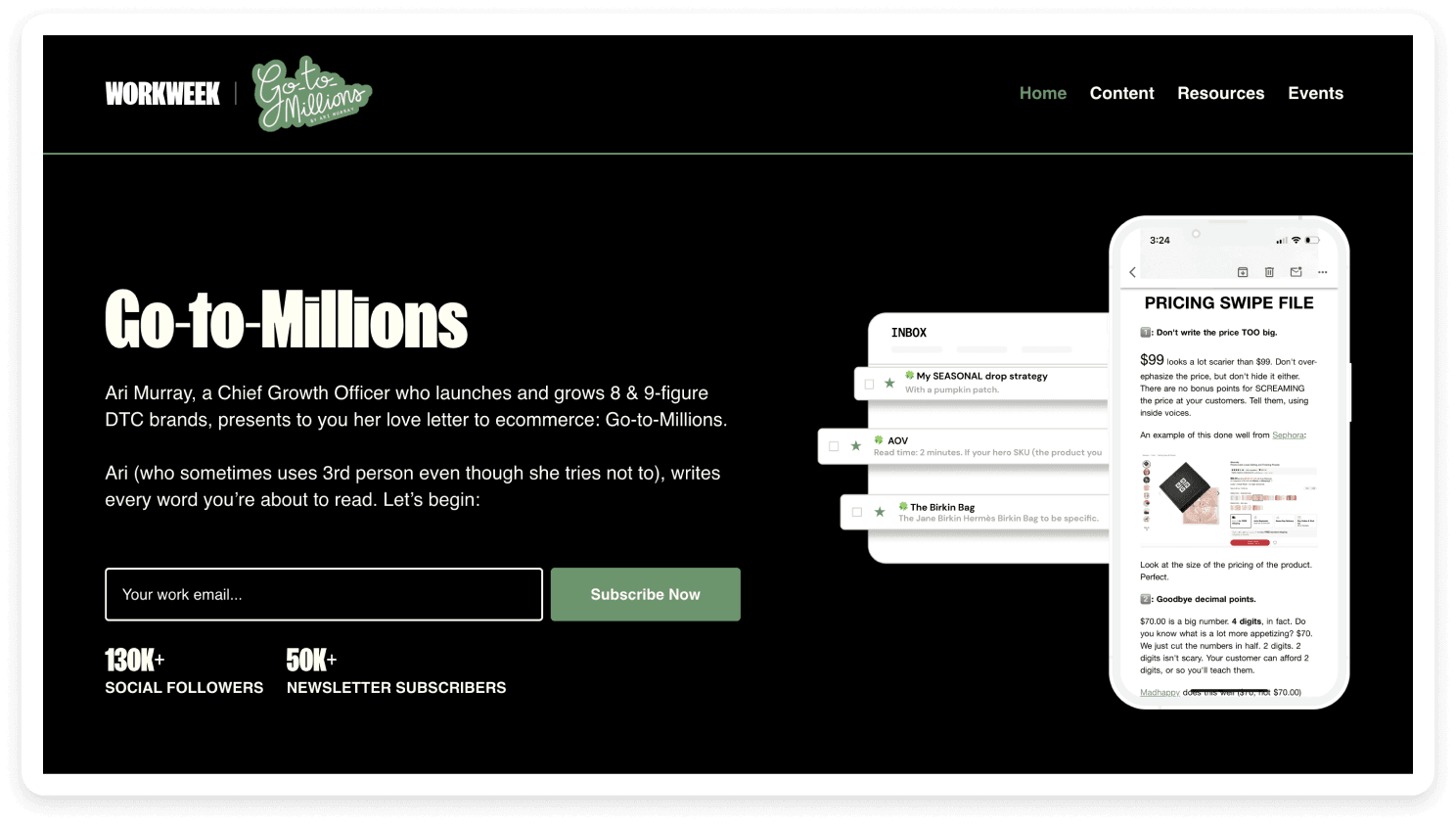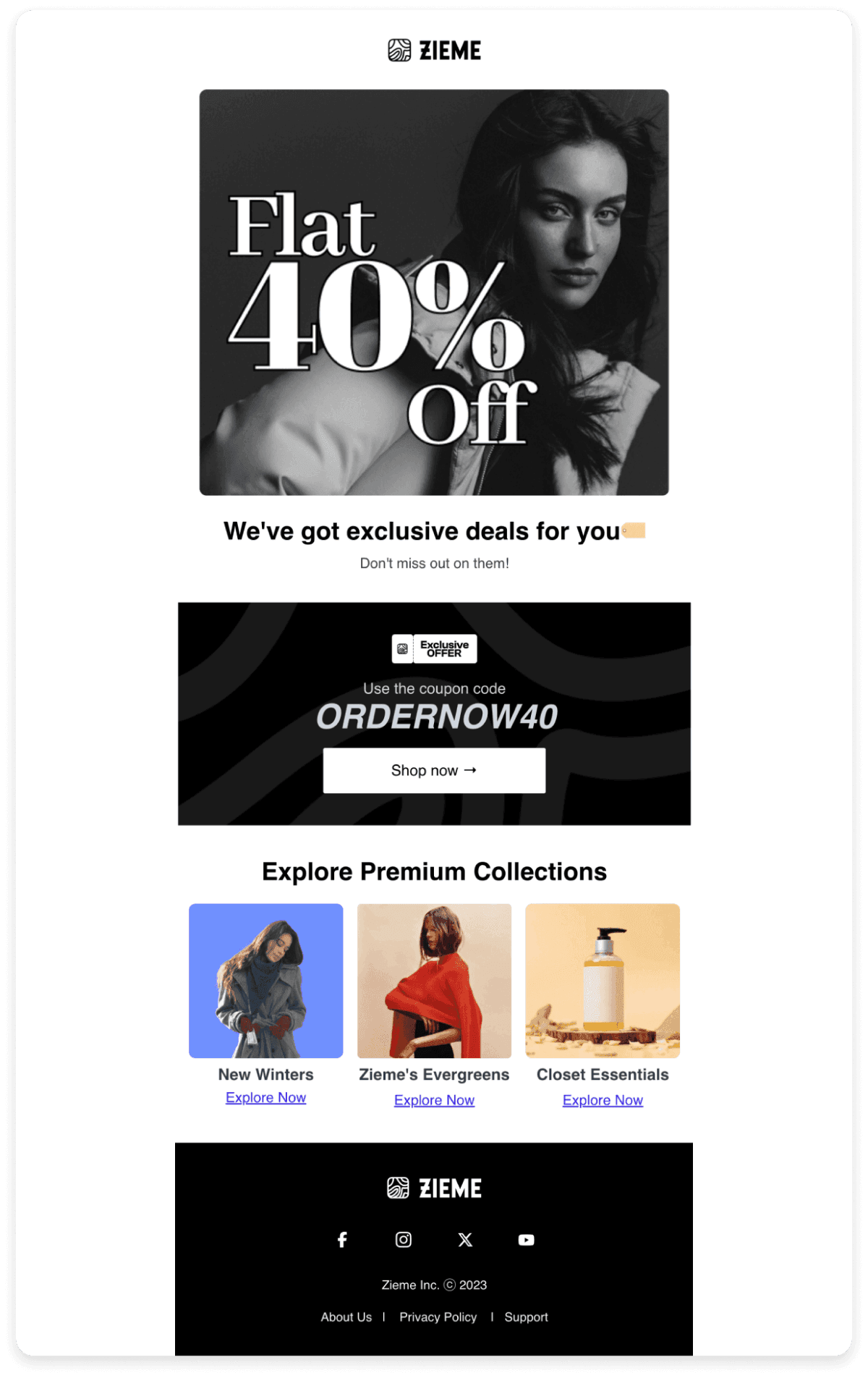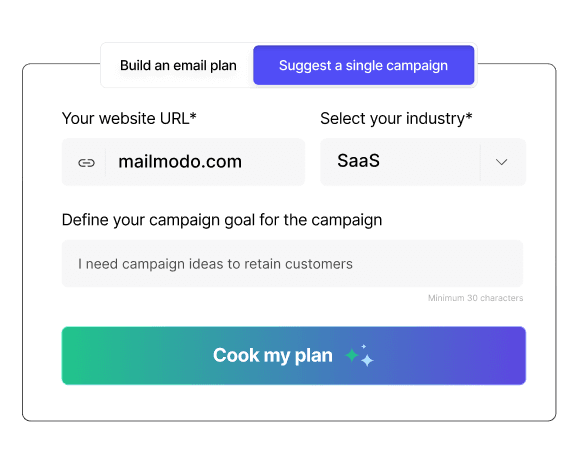What is email campaign management?
Email campaign management includes strategically planning and executing campaigns to engage your audience and drive meaningful results. Managing an email campaign involves handling logistics such as scheduling, content creation, and ensuring timely delivery to your subscribers.
Who needs email campaign management frameworks?
Every email campaign has the potential to engage, inform, and convert your audience. However, without a structured approach, even the best-designed email campaigns can miss their mark. This is where an email campaign management framework comes into play.
An effective email strategy is built on three core components:
- Content
- Segmentation
- Send strategy
If you are somebody who sends email marketing campaigns, you could be doing one of the two things discussed below and you need the email campaign management framework:
1. You run small email campaigns launched frequently
For businesses running small, frequent email campaigns, consistency and relevance are key to maintaining audience engagement. Small email campaigns are usually sent to about 10,000 to 30,000 subscribers every month, and they include:
Newsletters
Newsletters are sent regularly to keep your audience informed about company updates, industry trends, and valuable insights.

They are typically sent on a regular basis, such as weekly or monthly.
Product releases
Product release emails are designed to create buzz and excitement around new products or updates within your product line. They are targeted towards existing customers who may be interested in upgrading or expanding their usage.

They can also be targeted at prospects who have shown interest in similar products. These emails typically highlight key features, benefits, and improvements of the new products.
Product release emails often include clear calls to action (CTAs) directing recipients to learn more, pre-order, or purchase the product, driving immediate action from interested parties.
Offer emails
Offer emails are promotional messages aimed at driving sales through discounts, special deals, or limited-time offers.

These emails are often segmented based on customer behavior, preferences, or purchase history to personalize the offer.
2. You run very large-scale campaigns (VLSCs)
VLSCs involve sending a large volume of emails to a vast audience within a short timeframe, say a Black Friday sales campaign. These are typically used for major events, seasonal sales, or time-sensitive promotions.
Managing VLSCs requires robust email infrastructure, including scalable email service providers, dedicated IP addresses, and careful management of sender reputation and deliverability. These email campaigns need meticulous planning to ensure they maintain high deliverability rates, avoid spam filters, and engage recipients effectively despite the volume of emails sent.
What is the downside of not having an email campaign management strategy?
As someone who sends out a high volume of email campaigns, I've learned firsthand that without a solid strategy, things can quickly veer off course. In 2023, Amazon mistakenly sent out fake order confirmation emails, causing confusion and frustration among recipients who received notifications about purchases they didn't make. This incident highlights the importance of robust email campaign management practices.
Poorly managed email campaigns can lead to several pitfalls:
1. Low engagement and unsubscribes: Irrelevant or poorly timed emails can result in low engagement rates, increased unsubscribe rates, and damage to your sender reputation. This diminishes the effectiveness of future campaigns and limits your ability to reach your audience.
2. Brand reputation damage: Sending too many emails, irrelevant content, or technical issues such as broken links or formatting errors can tarnish your brand's reputation. Negative perceptions can lead to decreased trust and loyalty among subscribers.
3. Legal and compliance issues: Non-compliance with data protection regulations (e.g., GDPR, CAN-SPAM Act) can result in hefty fines and legal consequences. It’s crucial to adhere to email marketing laws and obtain proper consent from recipients to avoid legal pitfalls. You must also refer to the email sender guidelines by Google and Yahoo.
4. Wasted resources: Without a clear strategy and effective management, you may waste valuable resources on ineffective campaigns that do not yield the desired results. This includes time and money spent on content creation, email design, and campaign execution.
5. Missed opportunities: Inconsistent or sporadic email communications can cause businesses to miss opportunities to nurture leads, promote new offerings, or capitalize on seasonal trends. A lack of strategic planning may result in missed revenue opportunities and reduced customer engagement.
Create campaign ideas with
AI Email Campaign Planner
The 7C framework for email campaign management
Using frameworks in email campaign management provides a structured approach that ensures consistency, efficiency, and scalability across your email marketing efforts. It helps teams clarify goals, segment audiences effectively, and deliver personalized content that resonates with recipients.

For each component of the 7C framework, we will provide you with key questions to ask yourself and some tips for implementation, giving you a head start.
1. Clarity in campaign strategy
Unclear objectives and audience segmentation can result in low engagement rates and poor campaign performance. Marketers report a 760% increase in email revenue from personalized and segmented campaigns.
Questions to ask:
- What is the primary message or theme of your campaign?
- How will you differentiate your campaign from competitors in the industry?
- What customer pain points or needs does your campaign address?
- What tone and voice will you use in your campaign emails to resonate with your audience?
- How will you integrate your campaign with other marketing channels for maximum impact?
- What metrics will you use to measure the success of your campaign?
- How will you handle feedback and engagement from recipients during and after the campaign?
- What level of personalization will you incorporate into your campaign emails?
- How frequently will you communicate with your audience during the campaign period?
Implementation guideline:
To ensure contextual clarity in your campaign strategy, start by defining clear, measurable objectives for your email campaign. Outline the primary message or theme of your campaign and identify how you intend to differentiate your offerings from competitors within the industry.
You should identify your target audience and segment them based on demographics, behaviors, or past interactions.
You can use different tools to do so or manually segment your audience based on available data points. Create campaigns with a consistent tone and voice that resonates with your audience's preferences and needs.
Next, select appropriate metrics to monitor and evaluate campaign performance, such as open rates, click-through rates (CTRs), and conversion rates. This is not a one-time job. You will need to regularly test, review, and adjust your segmentation strategy to optimize campaign performance over time.
2. Coordination and scheduling
If you are running a VLSC campaign or multiple campaigns simultaneously, coordinating email campaigns across teams will be challenging. Without efficient coordination and scheduling, teams may overlap tasks or miss crucial deadlines. Poor coordination can result in disjointed efforts and a lack of campaign coherence.
Questions to ask:
- How can we ensure clear roles and responsibilities for email campaign tasks?
- Which tools can streamline task assignment and tracking for email content creation and approval?
- What strategies improve the review and approval process to prevent delays?
- How should we manage the email-sending schedule to avoid overlaps or gaps?
Implementation guideline:
Start by establishing clear campaign objectives and timelines, ensuring all stakeholders are aligned. You can use project management tools such as Asana or Trello to assign tasks, set deadlines, and track progress. If tools aren't available, create a shared spreadsheet or Notion document outlining tasks, responsibilities, and deadlines.
You must also regularly communicate updates and progress to ensure transparency and accountability across teams.
3. Content and personalization
Emails with personalized subject lines are 50% more likely to be opened. You don’t want to send generic emails that receive poor engagement or feel disconnected from your audience, all because you are running large campaigns!
Without relatable content and effective personalization, emails may fail to resonate with recipients, resulting in low open rates, high unsubscribe rates, and missed conversion opportunities.
Questions to ask:
- What types of content will resonate best with each segment?
- How can we measure the success of our segmentation efforts?
- How can we create content that speaks directly to our audience's needs and interests?
- What tools or strategies can enhance email personalization, such as dynamic content or segmentation?
- How do we maintain a balance between personalized content and brand messaging?
- How can we leverage customer data to tailor content for different segments of our audience?
- How do we use AI to personalize emails at scale?
Implementation guideline:
Start by analyzing customer data to identify key demographics, preferences, and behaviors. You can use email marketing tools like Mailmodo or Klaviyo to segment your audience based on these insights.
Next, create personalized subject lines and email copies that resonate with each segment's specific needs and pain points. You can also try out Mailmodo’s AI email subject line generator to generate subject lines within seconds.
You can also experiment with AMP-powered interactive emails that allow dynamic content blocks to personalize email content further.
You can also include other interactive elements like forms and polls that encourage users to actively participate. This creates opportunities for them to take immediate action. This engagement over time leads to increased conversion rates from your email campaigns.
Moreover, interactive emails contribute to a better overall user experience. They streamline the user journey, making it more enjoyable and efficient for recipients to interact with your content. This positive experience encourages initial engagement and fosters repeat visits and loyalty to your brand.
If you want to learn more about adding interactive emails to your campaign, you can read our detailed guide below.
4. Continuous testing and optimization
Neglecting testing and optimization can result in stagnant campaign performance, missed opportunities for improvement, and lower engagement rates. Companies that A/B test every email see email marketing returns 37% higher than brands that never include A/B tests.
Questions to ask:
- How often should we conduct A/B testing for email subject lines, content, and CTAs?
- What metrics should we focus on during testing to gauge campaign effectiveness?
- How can we gather actionable insights from testing results to optimize future campaigns?
- What tools or platforms are best suited for conducting email campaign testing and optimization?
- What role does customer feedback play in the testing and optimization process?
Implementation guideline:
When conducting A/B testing for your email campaigns, it's important to focus on specific metrics to understand and optimize your emails' effectiveness. Here are key metrics to test and why they matter:
| Metrics |
What are you testing? |
| Open rate |
subject lines |
| Click-through rate (CTRs) |
content layouts, CTAs, button colors |
| Conversion rate |
email designs, copy variations, incentive offers |
| Bounce rate |
sender names, email formats, list hygiene |
| Unsubscribe rate |
email frequency, content relevance |
5. Compliance and legal check
Non-compliance can lead to hefty fines, damage to brand reputation, and even legal actions. Each separate email in violation of the CAN-SPAM Act is subject to penalties of up to $51,744, so non-compliance can be costly.
Compliance with regulations isn't just about avoiding fines; it's about building trust with your audience and protecting your brand reputation.
Questions to ask:
- Have we ensured that all recipients have opted in to receive this email in compliance with GDPR and CAN-SPAM regulations?
- Is the email content clear and transparent about its purpose and identity?
- Are we providing an easy-to-find method for recipients to unsubscribe if they choose?
- Are there any personalization elements in this email that could be misinterpreted or inappropriate?
- Have we reviewed the email for any potentially misleading or deceptive language or claims?
- Have we double-checked all links and attachments to ensure they are accurate and secure?
Implementation guideline:
The first step is to familiarize yourself with GDPR, the CAN-SPAM Act, and other relevant regulations impacting email marketing. The bare minimum is to implement clear consent practices and obtain explicit opt-ins from recipients.
You should safeguard customer data with encryption, secure storage, and compliant data handling practices. It’s important to honour unsubscribe requests promptly and maintain a streamlined process for opt-outs.
You can read more about the 2024 bulk email sender guidelines by Gmail and Yahoo in our detailed guide below.
6. Consistency in email deliverability
Poor email deliverability can significantly impact campaign effectiveness, leading to low open rates, reduced engagement, and loss of resources. You must always keep a check on email deliverability and follow the best practices to maintain it.
Questions to ask:
- What factors influence our sender reputation, and how can we maintain a positive reputation?
- Are any technical issues, like poor email authentication or domain reputation issues, affecting our deliverability?
- How often should we monitor and clean our email lists to maintain deliverability standards?
- What steps can we take to optimize email content and formatting for better deliverability?
- How can we leverage email service providers (ESPs) and email authentication protocols (DKIM, SPF, DMARC) to enhance deliverability?
Implementation guideline:
The first step is to monitor and maintain a positive sender reputation by following best practices and avoiding spammy tactics. Implement email authentication protocols (DKIM, SPF, DMARC) to verify sender identity and improve deliverability.
You should regularly clean and update email lists to remove inactive or invalid addresses. Craft emails that are relevant, engaging, and free from spam triggers to increase the chances of inbox placement.
We all recognize the importance of analyzing our email campaign performance, yet it's a step that often gets overlooked or rushed in the eagerness to move on to the next campaign. Effectively analyzing performance metrics isn't just about ticking a box; without it, you might not know where you're headed or where to improve.
Questions to ask:
- What key metrics should we prioritize when analyzing email campaign performance?
- How do we define success for our email campaigns, and what benchmarks should we set?
- What tools or platforms are best suited for analyzing email performance metrics like open rates, click-through rates, and conversion rates?
- How can we use A/B testing to optimize campaign elements and improve performance over time?
Implementation guideline:
Analyzing campaign performance begins with setting clear objectives and defining key performance indicators (KPIs) such as open rates, click-through rates (CTR), conversion rates, and return on investment (ROI). These metrics serve as benchmarks to measure the success of your email campaigns. Tools like Google Analytics, Mailchimp, or HubSpot provide robust analytics dashboards where you can track these metrics effectively.
Once your campaign is launched, collect data systematically using these tools. Monitor metrics in real time to gauge initial performance trends. Look beyond the surface metrics like open and click-through rates; dive deeper into engagement metrics like time spent on email, interactions with embedded content (videos, polls), and conversion tracking.
Compare performance against previous campaigns and industry benchmarks to assess effectiveness. For instance, if a particular subject line consistently yields higher open rates, replicate that strategy in future campaigns.
Start using the 7C framework today
To sum up, effective email campaign management relies on using a structured approach like the 7C framework. By following this framework, marketers can tackle challenges and seize opportunities in email marketing. It ensures clear goals are set, campaigns are optimized based on insights, and results are measured accurately. It boosts engagement and conversions but also supports long-term business growth.
If you find this framework difficult to follow or think that it’s too advanced for you right now and you want to learn more about the basics of email marketing. You can take our 90-minute email masterclass today.















